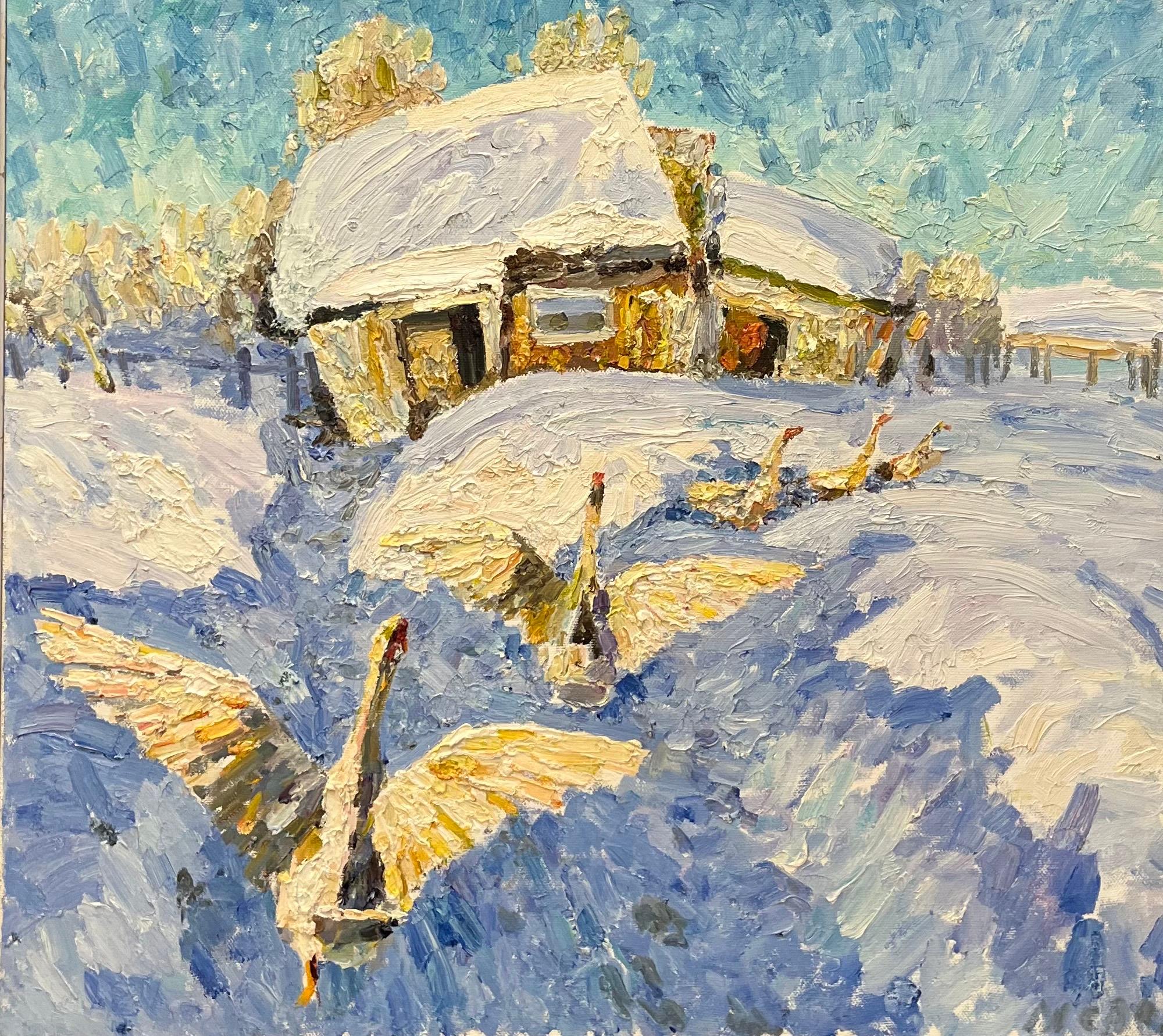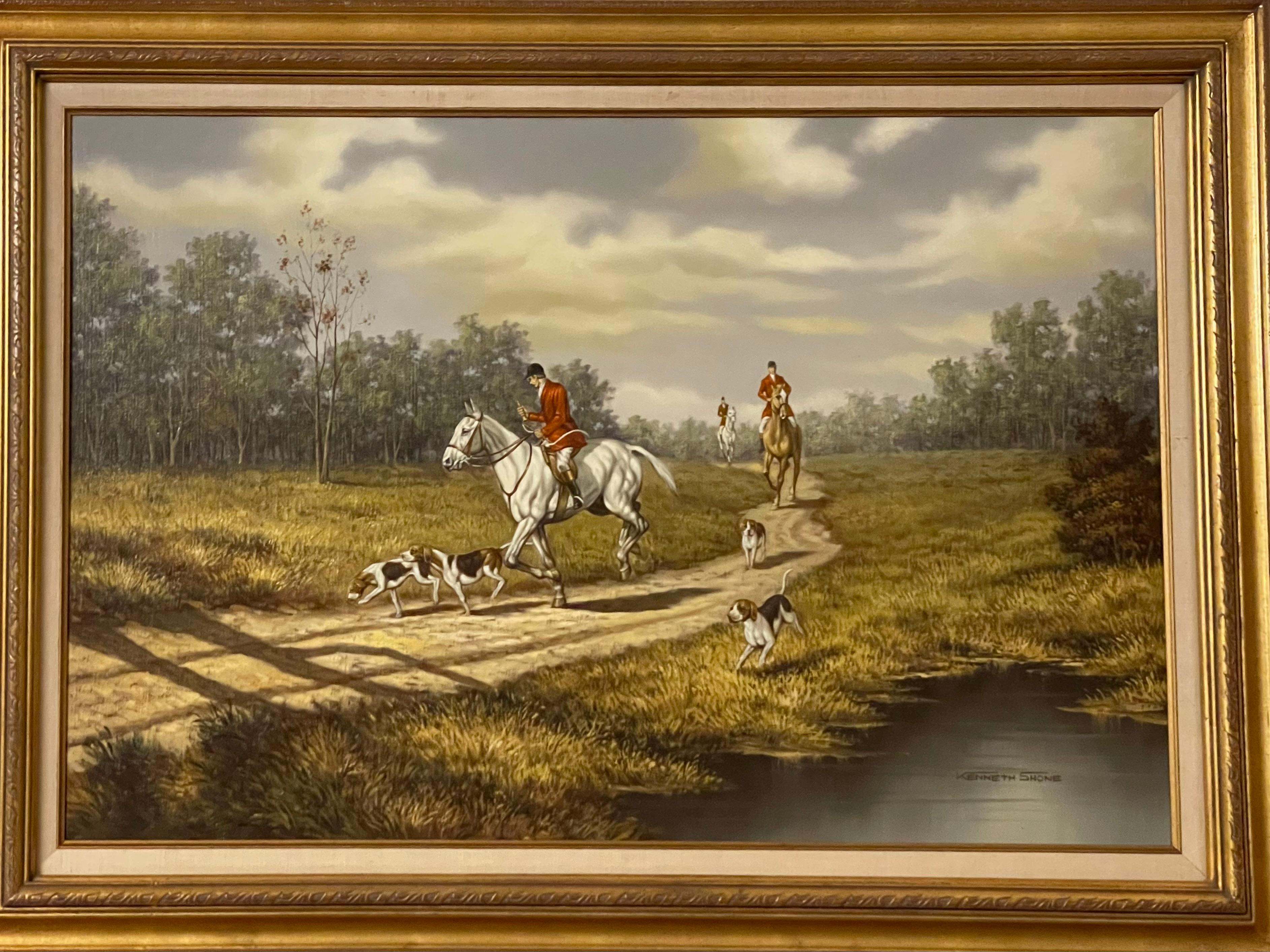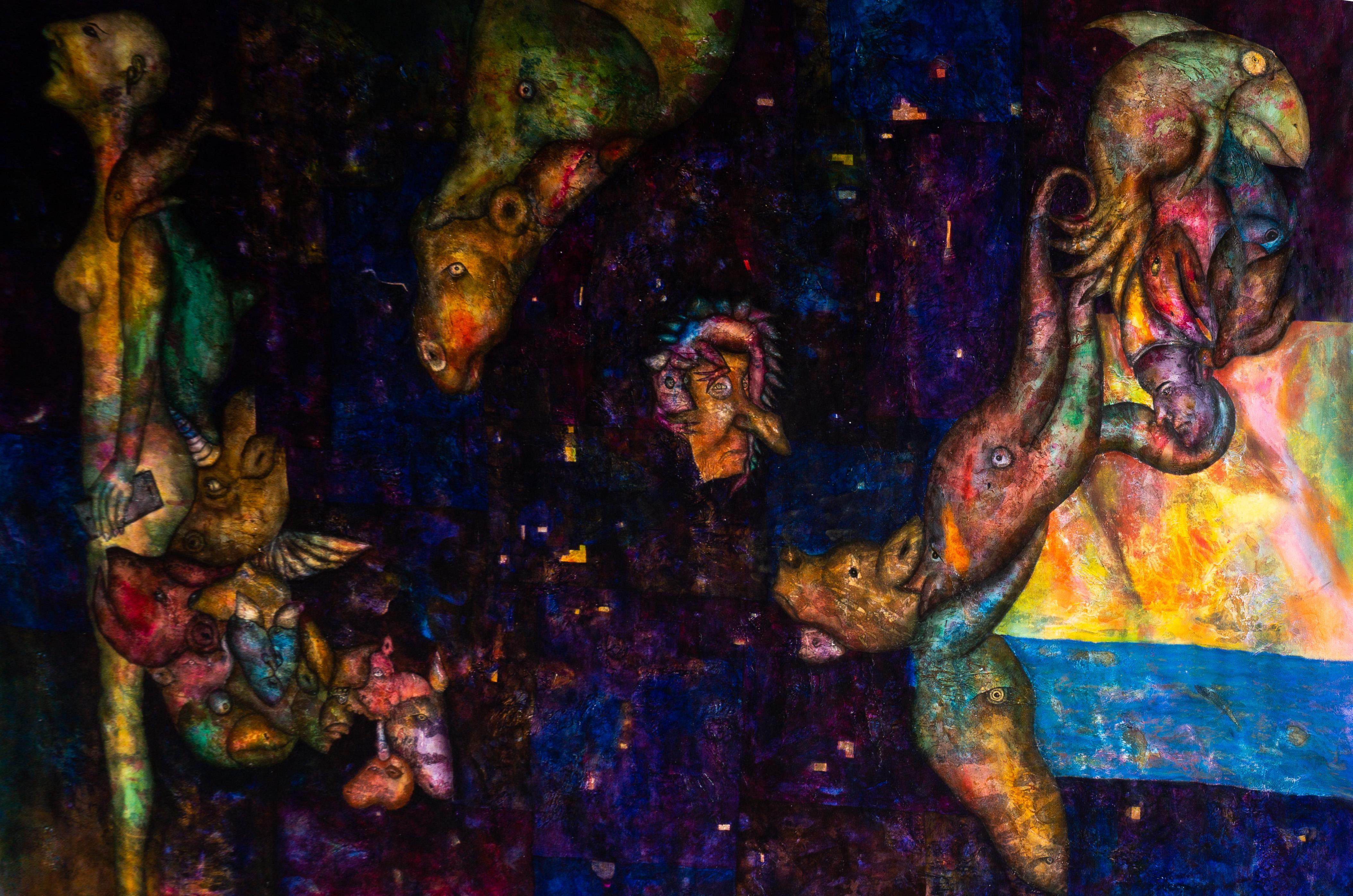Items Similar to "Arab Scouts, " Adolph Schreyer, Middle Eastern Orientalist Scene with Horses
Want more images or videos?
Request additional images or videos from the seller
Adolf Schreyer"Arab Scouts, " Adolph Schreyer, Middle Eastern Orientalist Scene with Horses
About the Item
Adolph Schreyer (1828 - 1899)
Arab Scouts, n.d.
Oil on canvas
33 3/4 x 56 inches
Signed lower right
Housed in an exceptional period American handcarved frame
Provenance:
Sheridan Art Gallery, Chicago
Private Collection, Chicago
Traffic Club of Chicago
Schreyer expert Dr. Christoph Andreas has kindly confirmed the authenticity of this work.
With the increase in travel by steamship and the political involvement of European powers in North Africa and the Middle East in the nineteenth century, paintings depicting the scenery, daily life, and customs of North African and Middle Eastern people became an object of fascination among European and American audiences. The German artist Christian Adolf Schreyer, one of the best known of the so-called Orientalist painters who specialized in these foreign scenes, was particularly renowned for his lively depictions of horses. Schreyer traveled to Egypt and Ottoman Syria in 1859 and to Algeria in 1861; during these trips he learned various Arabic dialects and immersed himself in local culture, including riding with Bedouin nomads.
- Creator:Adolf Schreyer (1828-1899, German)
- Dimensions:Height: 41 in (104.14 cm)Width: 63 in (160.02 cm)
- Medium:
- Period:
- Condition:Relined, skillfully repaired folded area to canvas in upper quadrant. Otherwise excellent overall condition.
- Gallery Location:New York, NY
- Reference Number:1stDibs: LU184129923472
Adolf Schreyer
Adolf Schreyer (1828-1899) was a renowned German artist known for his exceptional skill in painting equestrian and Orientalist subjects. Born on May 9, 1828, in Frankfurt am Main, Germany, Schreyer showed a talent for art from a young age. At the age of 16, Schreyer began his formal artistic training at the Städel Institute in Frankfurt. He later traveled to Düsseldorf, where he studied under the influential landscape and genre painter, Johann Wilhelm Schirmer. Under Schirmer's guidance, Schreyer developed a keen eye for capturing atmospheric effects and natural landscapes. In 1854, Schreyer embarked on a journey that would have a profound impact on his artistic career. He traveled to North Africa, including Algeria and Egypt, where he immersed himself in the vibrant culture and landscapes of the region. The time spent in the Orient greatly influenced his artistic style and subject matter. Schreyer's paintings often depicted scenes of Arab horsemen engaged in battle or moments of intense action. His ability to capture the energy and movement of horses, as well as the exoticism of the Oriental settings, earned him considerable acclaim. His works were highly sought after by collectors and art enthusiasts of his time. The artist's Orientalist works were characterized by their meticulous attention to detail, vibrant colors, and dramatic lighting. Schreyer's ability to convey the intensity of battle scenes, the grace of horses in motion, and the rich cultural traditions of the Arab world set him apart as a master of his craft. Throughout his career, Schreyer received numerous accolades and recognition for his art. He exhibited his works extensively in Germany and other European cities, including Paris and Vienna. Schreyer's paintings were also well-received in America, where they found a significant market. Today, Adolf Schreyer's works can be found in prestigious museums and private collections around the world. His legacy as one of the foremost Orientalist painters of the 19th century continues to captivate art enthusiasts and collectors alike. Adolf Schreyer passed away on July 29, 1899, leaving behind a rich artistic legacy that remains influential to this day.
About the Seller
5.0
Platinum Seller
These expertly vetted sellers are 1stDibs' most experienced sellers and are rated highest by our customers.
Established in 2021
1stDibs seller since 2022
62 sales on 1stDibs
Typical response time: 1 hour
- ShippingRetrieving quote...Ships From: New York, NY
- Return PolicyA return for this item may be initiated within 3 days of delivery.
More From This SellerView All
- "Gwine to Eat it All Myself" William Holbrook Beard, Bears, Animals, Genre SceneLocated in New York, NYWilliam Holbrook Beard Gwine to Eat it All Myself, 1894 Signed and dated lower left Oil on canvas 16 x 24 inches Provenance: Childs Gallery, Boston Cynthia Bowers, New York Estate of the above Exhibited: New York, National Academy of Design, 1895, no. 405 ($500). Literature: American Art Review, January - February, 1975, p. 36, illustrated. Abraham A. Davidson, The Eccentrics and Other American Visionary Painters, Boston, 1978, p. xvii. Born in Painesville, Ohio, William Beard...Category
1890s Animal Paintings
MaterialsCanvas, Oil
- "The Coming Storm, " Walter Shirlaw, Flock of Birds in a LandscapeBy Walter ShirlawLocated in New York, NYWalter Shirlaw (1838 - 1909) The Coming Storm Oil on canvas 18 x 26 inches Signed lower right Exhibited: The Boston Art Club. Walter Shirlaw, born on August 6, 1838, was only three (fourteen according to one obituary) when he came to Hoboken, New Jersey from his place of birth, Paisley, Scotland. As a young man, he found work as a bank note engraver, a profession that he continued in Chicago, where he lived between 1865 and 1870. But already in 1861 he was exhibiting genre paintings at the National Academy of Design. In 1868, Shirlaw was a member of the Chicago Academy of Design, which would become the Art Institute of Chicago, after changing its name from the Chicago Academy of Fine Arts. Shirlaw spent the years 1870-77 in Munich, at the height of the movement led by Wilhelm Leibl in which a low-keyed, dark palette, combined with bold, virtuoso brushwork, were applied to realist subject matter. Michael Quick (in Quick, Ruhmer, and West, 1978, p. 28) defined the time of Shirlaw's arrival (1870-73) as an especially experimental period in progressive German painting. Shirlaw's teachers, however, sided with tradition. The genre painter Arthur Ramberg (1819-1895) and Wilhelm von Lindenschmidt (1829-1895), his successor at the Munich Academy, taught Shirlaw composition. The painter of genre scenes and landscapes, Alexander von Wagner (1838-1919) was Shirlaw's teacher in painting. T. H. Bartlett (in American Artists and Their Works, 1889, vol. 1, p. 23) mentioned that Shirlaw regarded Leibl as too realistic. Shirlaw won a scholarship at the Academy in 1874, the year in which he executed Toning the Bell (Art Institute of Chicago). Meanwhile, he was active as one of the "Duveneck Boys" in Polling. Sheep Shearing in the Bavarian Highlands (Private collection), painted under Lindenschmidt's direction in 1876, is regarded as one of Shirlaw's most important pictures. He exhibited it upon his return to America at the National Academy in the following year; in 1878, it won an Honorable Mention in Paris. In 1877, the second school year of the Art Students League, Lemuel E. Wilmarth announced that he would be returning to teach at the NAD. Frank Waller (1842-1923) took over as president of the ASL, and Shirlaw was hired to teach painting and drawing. The appointment was endorsed by Waller: "In Munich . . . he was regarded as one of the strongest of the American students and had the strong personality which would attract and influence others to have confidence in him, was so genuine in his artistic impulses and in his interest in the development of art in this country. . . ." (quoted by Landgren, 1940, p. 32). The hiring of Shirlaw and William Merritt Chase seemed to signify a preference of Munich over Paris among the members of the Art Students League, however, while Chase was under Leibl's spell, Shirlaw was strictly academic. During the fourth season at the ASL, Shirlaw taught composition. Thomas Wilmer Dewing...Category
Late 19th Century Impressionist Landscape Paintings
MaterialsCanvas, Oil
- "Bucolic Landscape, " Sally Michel Avery, Female American Modernist Bright PastelBy Sally Michel-AveryLocated in New York, NYSally Michel Avery (1902 - 2003) Bucolic Landscape with Cows, 1963 Oil on canvasboard 9 x 12 inches Signed and dated lower left Provenance: The art...Category
1980s American Modern Landscape Paintings
MaterialsBoard, Oil, Canvas
- "Crane, " Decorative Japanese School Painting of White BirdLocated in New York, NYJapanese School Crane Oil on paper, laid on Masonite 59 1/2 x 47 inches Signed in JapaneseCategory
20th Century Animal Paintings
MaterialsMasonite, Paper, Oil
- "African Elephant Walking, " Spencer Hodge, Safari Wildlife Animals, RealismLocated in New York, NYSpencer Hodge (British, b. 1943) African Elephant Walking Oil on canvas 38 x 50 1/2 inches Signed lower right Spencer Hodge attended the Hastings School...Category
Late 20th Century Realist Animal Paintings
MaterialsCanvas, Oil
- "Interior of a Stable" William Hart, Hudson River School Antique, Boy and HorseBy William HartLocated in New York, NYWilliam M. Hart (1823 - 1894) Interior of a Stable Oil on canvas 17 x 12 inches Provenance William Macbeth Gallery, New York Mrs. Mabel Brady Garvan Collection Christie's New York, Sporting Art, November 28, 1995, Lot 116 Ann Carter Stonesifer, Maryland Estate of above Brunk Auctions, Asheville, North Carolina, January 27 2018, Lot 777 Exhibited New York, The Metropolitan Museum of Art, Life in America, April 24 - October 29, 1939, no. 123, illustrated. New York, Macbeth Gallery, 1892: Sixtieth Anniversary Exhibition, April 1952, p. 5, no. 18. Literature Turner Reuter Jr, Animal and Sporting Artists in America, Middleburg, Virginia, 2008, p. 306. Gary Stiles, William Hart: Catalogue Raisonné and Artistic Biography, no. 1126, illustrated. It should be noted that the Francis Patrick Garvan and Mrs. Mabel Brady Garvan collection, of which this painting was a part of, was one of the foremost American Art collections and now makes up a large part of the Smithsonian American Art Museum and the Yale University Art Gallery collections. Born in 1823 in Paisley, Scotland, William Hart emigrated with his parents to the United States at the age of nine and settled in Albany, New York. It was here that Hart first began his artistic training when he was placed under the tutelage of Messrs, Eaton & Gilbert, the prestigious coach-makers from Troy, New York. During this time, Hart learned how to decorate coach panels, covering them with either landscapes or figurative compositions. At the age of seventeen, he was eagerly contemplating an artist’s profession. Consequently, he left the mechanical trade of coach-making and began expanding his artistic pursuits to more refined endeavors. Hart followed coach-making with decorating window shades and later developed an interest in portraiture. Around 1840, he established his first formal studio in his father’s woodshed in Troy. There, he created many likenesses of individuals, affording him a nominal income. Once, he remarked that he felt prouder over his first fee of five dollars for painting a head then for the larger sums he would command later in his career. Nevertheless, his wages from portraits during this early period proved insufficient. Thus, he expanded into landscape painting, allowing him to barter his works or sell them for modest prices. In 1842, Hart moved to Michigan in an attempt to further his success; portraiture remained his primary means of support. Unfortunately, his experiences in the West were disappointing. Hart spent three years living a rough existence until he finally returned to Albany in 1845. Upon his return, he fully devoted himself to the art of landscape painting. Despite his failing health, he worked diligently to perfect his skill until 1849 when he traveled abroad to his native land of Scotland. This trip was made possible through the generosity of his patron and advisor, Dr. Ormsby of Albany. For three years, he studied in the open-air, creating brilliant sketches of the Scottish Highlands and the surrounding British Isles. Returning to Albany once more in 1852, Hart enjoyed improved health and was reinvigorated with purpose. The following year, he moved to New York and opened a studio, promoting himself as a specialist in landscape painting. Hart became a regular contributor to the National Academy of Design. His works received a great deal of attention from artists and connoisseurs alike, all of whom praised him for his fresh, self-taught style. In 1855, he was designated as an associate of the National Academy of Design; three years later he was elected to Academician. In 1865, he was unanimously chosen to be the first president of the Brooklyn Academy of Design. It was during his tenure there that he delivered his famous lecture The Field and Easel, which emphasized the distinguishing principles of landscape art in America. Hart argued that landscape painters should express the “look of the place” being depicted.Critics during the 1870s noted his sensitive balance between capturing a strict “real” interpretation of nature and that of a more “ideal” sentimental tone. For instance, in 1869, Putnam Magazine noted that Hart brought back “exquisite studies” of the surrounding Tappan...Category
19th Century Hudson River School Animal Paintings
MaterialsCanvas, Oil
You May Also Like
- A WolfLocated in New York, NYProvenance: The Marchesi Strozzi, Palazzo Strozzi, Florence Sale, Christie’s, London, May 20, 1993, lot 315, as by Carl Borromaus Andreas Ruthart...Category
17th Century Old Masters Animal Paintings
MaterialsPaper, Canvas, Oil
- Van der Bent, Southern Landscape with woman animals, Dutch Old Master, BerchemLocated in Greven, DE17th Century Old Master, Figurative and Landscape Painting by Jan Van der Bent So far, little is known about the life and work of Jan van der Bent. He was...Category
17th Century Baroque Landscape Paintings
MaterialsCanvas, Oil
- "Geese in the snow" oil cm. 100 x 80By Georgij MorozLocated in Torino, ITSnow, geese,white,Ukraine Georgij MOROZ (Dneprodzerzinsk, Ucraina, 1937 - St. Petersburg, 2015) 1937: he was born in Dneprodzerzinsk, Ucraina. 1949-56: he began artistic studies in ...Category
Early 2000s Impressionist Animal Paintings
MaterialsCanvas, Oil
- Fox HuntLocated in Hillsborough, NCOil painting of horses and hounds set on a country road, this is a contemporary 20th century landscape painting in excellent condition. The color is c...Category
Mid-20th Century Realist Animal Paintings
MaterialsCanvas, Oil
- Motherlove, Constant Artz, Oil paint/canvas, ImpressionismLocated in OOSTERBEEK, NLNetherlands, 1870-1951 Constant Artz is the painter of the well-known extremely friendly and sunny scenes with a duck with young ones on the side of a ditch. He was born in Paris in...Category
19th Century Impressionist Animal Paintings
MaterialsOil, Canvas
- Blue DreamLocated in Bogotá, BogotáImmerse yourself in a unique visual experience with this oil painting in shades of blue and violet. The artwork features enigmatic figures of men and animals coming to life in a noct...Category
2010s Surrealist Animal Paintings
MaterialsPastel, Oil, Cotton Canvas
Recently Viewed
View AllMore Ways To Browse
Chicago Antique
Arab Art
Middle Eastern Art
19th Century American Politics
Eastern European Artists
Artist Arab
Antique Syrian
Antique Middle Eastern
Arabic Paint
Arab Paint
Arab Antique
Antique African American
African American Antique
Antique Riding Horse
African Horses
19th Orientalist Paintings
19th Century Orientalist Paintings
African American 19th Century






